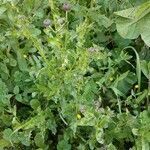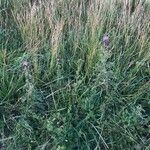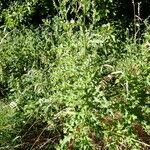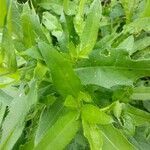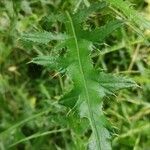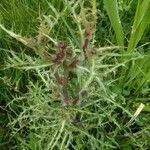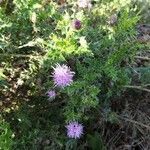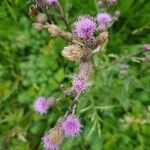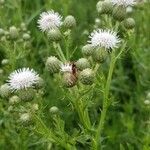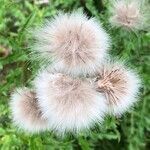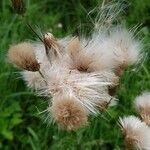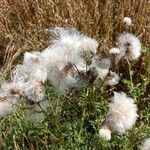Rhizomatous perennial often forming large patches. Stems branched above, with multicellular eglandular and fine cobwebby hairs below, becoming glabrous above, (20)-40-100-(150) cm tall, ribbed, not winged or sometimes with a spiny wing 0-1-(2) cm long decurrent from lf bases. Lvs lanceolate, pinnatifid, green above, pale beneath, (2)-4-15 × 1-5 cm, glabrous or with cobwebby hairs; lobes deltoid to lanceolate; prickles pale, 5-10 mm long. Capitula narrowly ovoid to cylindric at flowering, erect, 1.5-2-(2.5) × 0.7-1.5-(2) cm, in cymes or cymose panicles; peduncles 5-40 mm long. Outer involucral bracts lanceolate, cobwebby-ciliate; apex acuminate, with weak spine 1-(2) mm long, suberect. Inner involucral bracts linear, ciliate; apex acute, not spinous, erect. Corolla usually pale purple or mauve, sometimes white, 12-18 mm long; lobes c. 3 mm long. Style slightly exserted beyond corolla lobes. Achenes pale, cylindric, 3-4 × 1-1.5 mm; pappus 20-25 mm long, shorter in ♂; cilia on pappus bristles 2-3 mm long.
Herb to 1 m high. Rhizomes present, forming aerial shoots. Stems glabrous or arachnoid-hairy; wings absent or very short. Leaves green and glabrous or very sparsely arachnoid-hairy above, glabrous to densely arachnoid-hairy below; spinules and sessile glands absent from lamina; marginal spines 1.5–6 mm long, yellow-brown. Capitula 2–7 at ends of 5–10 cm long side-branches, of all male or all female flowers; involucre obovoid-cylindric, 8–14 mm diam. at anthesis; median involucral bracts erect, tapering, 4–10 mm long, 1.5–2.5 mm wide at base, with entire margins and recurved spinose apex, usually glabrous. Corolla purple; tube 10–16 mm long; female flowers with lobes 2.7–3.7 mm long; male flowers with lobes 4.5–6.2 mm long. Anthers 4–5 mm long. Achenes compressed narrowly ellipsoid, 2.5–3.5 mm long, straw-coloured. Pappus bristles 57–80, 15–22 mm long.
Colonial perennial 3–15(–20) dm from deep-seated creeping roots, subglabrous, or the lvs ± white-tomentose beneath; heads ± numerous in an often flat-topped infl, unisexual or nearly so, the plants polygamo-dioecious; invol 1–2 cm high, its bracts all innocuous, or the outer with a weak spine-tip ca 1 mm; fls pink-purple (white); achenes 2.5–4 mm; pappus of the pistillate heads surpassing the corollas, that of the staminate heads surpassed by the cors; 2n=34. A noxious weed of fields and waste places; native of Eurasia, now widely intr. in n. U.S. and s. Can. July, Aug. The var. arvense has merely toothed or shallowly lobed, weakly spiny lvs. (C. setosum; C. a. var. mite) The more common var. horridum Wimmer & Graebner has more spiny, deeply pinnatifid lvs.
Annual herb, 0.8-1.0 m high. Leaves alternate, often decurrent, pinnately lobed, lobes and teeth spinescent or rarely rigidly ciliate. Capitula discoid, many-flowered, solitary; involucral bracts in many rows, spiny. Florets bisexual, fully fertile or female; corolla purple, tube narrowly cylindric below, slightly widened above, deeply 5-lobed. Anthers linear, sagittate at base, adjacent auricles connate and prolonged into entire or lacerated tail. Style abruptly thickened below branches, often with ring of hairs there; branches, often partly connate. Flowering time Jan.? Pappus of feathery bristles in several rows; connate at base. Cypselae obovoid-oblong, glabrous, with nearly central, horizontal, basal attachment scar.
Herbs 30-160 cm tall, perennial, dioecious. Roots far creeping, bearing adventitious shoots. Stems erect, branched above, unwinged. Leaf surface smooth. Capitula often numerous, terminal, corymbose. Involucre ± narrowly ovoid, 1.5-2 cm in diam. Phyllaries imbricate, in 5-7 rows, lacking wings and scarious appendage; outer and middle phyllaries triangular to ovate, 3-8 × 1.2-2.5 mm, apex acute; inner phyllaries elliptic-lanceolate to broadly linear, 9-20 × 1-3 mm, apex acute to acuminate and scarious. Corolla reddish purple or rarely white; female florets 1.6-2.4 cm, tube 1.3-1.8 cm; male florets 1.5-1.8 cm, tube 0.9-1.2 cm. Achene yellowish, 3-4.5 mm. Pappus bristles dirty white, 2.5-3.5 cm.
A herb. It is a thistle which keeps growing from year to year. It grows up to 1 m high. It has creeping underground stolons. The flowering stems are branched and erect. They are furrowed and can be smooth or cottony. The leaves near the base are oblong to sword shaped. They have lobes along the sides. They are narrowed towards the base. The leaves are white and woolly underneath and have spines around the edge. The flowers occur singly or as 2-4 together and are purple. They are at the ends of the upper branches.
Perennial herb, 0.3-0.9 m high, sometimes up to 1.5 m. Heads small, discoid; flowers dioecious. Leaves entire to deeply pinnately lobed, margins with long and short spines; sessile, clasping. Flowers purplish, occasionally white.
